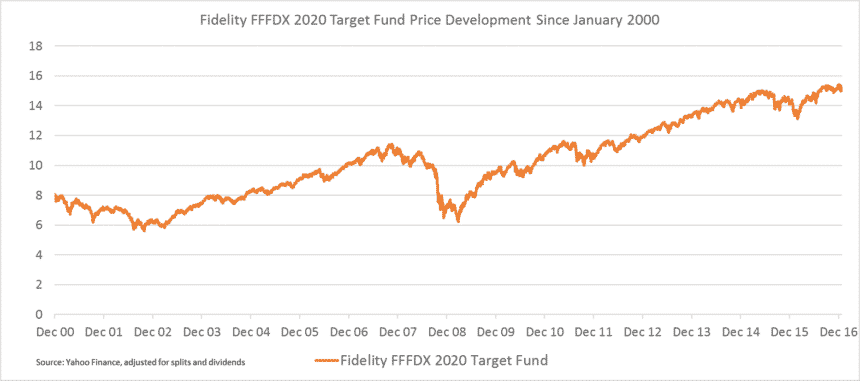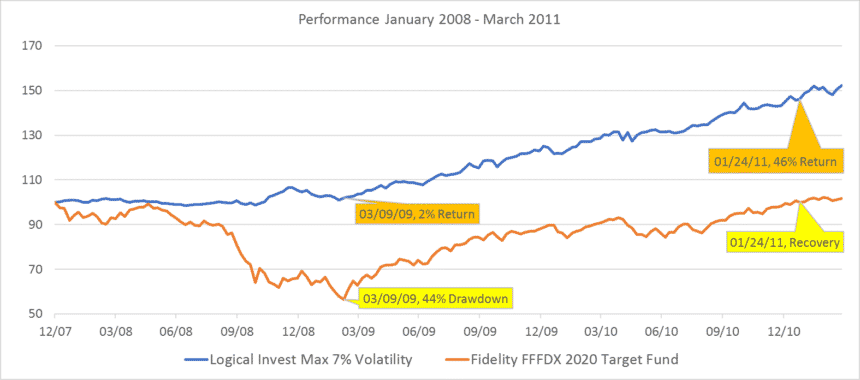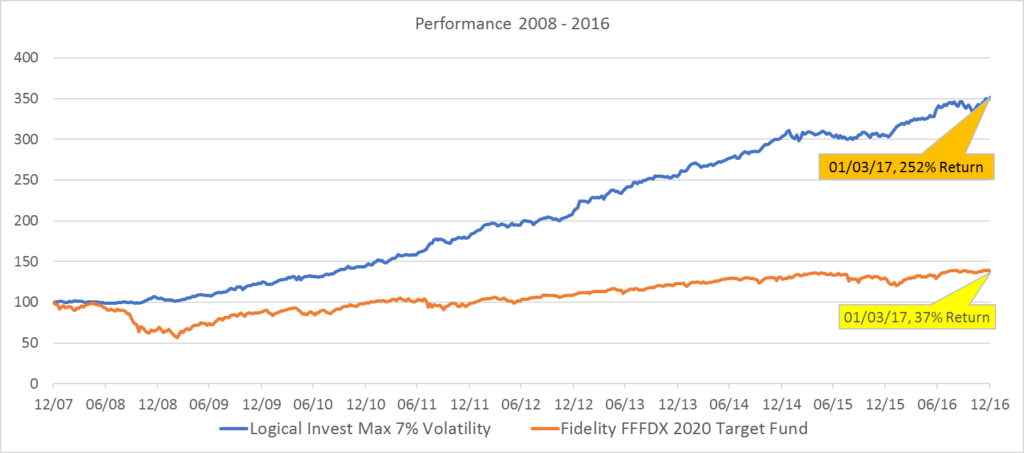We analyse one of the Fidelity Freedom Target Date Funds (FFFDX) versus a portfolio of ETF rotation strategies – The findings will surprise you!
This is a guest post by Richard Manley
Defined contribution retirement plan using target date funds
There’s no shortage of challenges facing working people in these days. In addition to job outsourcing and the offshoring whole operations, inflation/deflation and zero interest rates on savings, most workers who have a retirement plan have one that’s called a “defined contribution plan”, in the US in many cases it’s also called a 401K. In such a plan, a participant contributes before-tax funds, often matched to some degree by the employer, into an account that is intended to accrue and grow until retirement age when it can be distributed over one’s retirement lifetime. This kind of plan of course puts the responsibility and burden of making wise investment choices on the individual.
Most working folks are not trained in finance or security selection or portfolio construction and are thus left to rely on their own uninformed devices or advice from financial gurus in the media or in newsletters or cable TV talking heads, or merely to reactionary emotions that attend to most of us during extreme financial events. The U.S Dept. of Labor’s new “Fiduciary Rule” will take effect in April, but what practical effect this may have on individual’s specific investment actions under defined contribution plans remains to be seen.
As a retirement plan investor, I’ve experienced all these pitfalls and more while I’ve tried to save enough to comfortably retire someday. A coherent approach to managing my modest retirement assets was clearly lacking and as a result I found myself thrashing my account to respond to the newest advice amplified by my prejudices and emotions.
Portfolio Goal
Now, my goal is to establish a rationally allocated portfolio that will help grow my principal a little while exposing it to a minimum level of risk. The universe of options for a conservative retiree who would like both some performance as well as low risk in a simple, low-cost, stand-alone investment has proven difficult to find in the financial market today.
Default choices of target date funds
Saving for retirement is a harrowing enterprise. We all suffered the financial crisis and hope another is not baked into the policies of the last 8 years. During that period many of us experienced breathtaking reverses in our 401k accumulations. Many folks with defined contribution retirement plans have simply opted to accept a plan’s default mutual fund option and then leave it on autopilot. In my employer’s plan, one of the Fidelity Freedom Funds on offer for folks in my age bracket was the target date fund, Fidelity Freedom 2020. Here is Fidelity’s description of the target date fund, FFFDX.
As Investopedia reports “ … Target date fund is designed to be the only investment vehicles that an investor uses to save for retirement….”
Well, during the financial crisis period, from April 1, 2008 to mid-March 2009, the “designed for retirement accounts” Fidelity target date fund, FFFDX, declined in value by over 40%. Basically all the gains accrued over nearly the previous 5 years in the retirement plans of many individuals invested in this default option by Fidelity, had been wiped out.

I often heard that it’s best to stay the course – things will mean-revert and eventually get back to an historical trend line. And as I’ve also been told, the market and valuations can be irrational longer than I have patience or capital to withstand it. Emotions are very strong and can motivate us to do things that rationally we may think are incorrect. In my case, the appeal of immediate pain relief has overcome better judgement on more than one occasion. There are several moves I’d like be able to take back. In the heat of a 40% reduction in one’s retirement balance, and with the media shouting that “this time it’s different” – there may not be many who could face the situation without blinking – and selling, at just the wrong time. Folks invested in the Fidelity target date fund FFFDX during this time faced the then current reality of over 40% losses and had to deal with it emotionally.
Of course, the Fidelity Freedom 2020 came back eventually. By the end of January 2011, more than 2½ years later, it was back at the level it had achieved on April 1, 2008. By the end of September 2016, FFFDX had an adjusted return of about 42% measuring from April 1, 2008, a period of 8 ½ years, for a return of about 4.2% per year on average, if you had the stomach and patience to wait it out.
What else can be done instead of these Fidelity Target Date Funds?
So I’ve been interested finding a better way to manage my retirement account which is how I found and began to follow the Logical Invest (“LI”) strategies.
Let’s take a look at an analysis of the advice offered through my LI subscription. An LI Portfolio Builder run shows the performance for 17 different LI pre-configured portfolios assembled to meet a wide range of investment objectives. Consider one low volatility portfolio, the Max CAGR with Volatility<7% portfolio (MC/V7%). It offers a considerable contrast to the performance exhibited by the Fidelity 2020 target date fund FFFDX. This portfolio, comprising LI strategy-advised ETFs, suffered less than a 6% intra-month drawdown over the time period from April 2008 to March 9, 2009. While a 6% drawdown is not welcome of course, it beats 40%, and is not sufficient (probably) to lead me to panic, blink and sell; while 40%+ most likely would.
The MC/V7% portfolio exhibited another excellent attribute – it returned over 230% between the spring of 2008 and the end of September 2016, for a compound annual growth rate of over 19%. The advice from LI over this period was based simply on establishing a portfolio objective and then applying “adaptive asset allocation” by rebalancing monthly in accordance with momentum-related signals delivered from the LI models.
In both cases, the Fidelity Freedom target date fund FFFDX and the LI Max CAGR Vol<7%, the results showed staying the course during the financial crisis was a better choice than bailing out on March 9, 2009.
Well, how is that plan working out recently? The Fidelity 2020 fund FFFDX is up about 6% YTD (October 1, 2016) while the LI Max CAGR Vol< 7% is ahead by about 16% for the year as of September 30, according to the LI online Portfolio Builder. But short term, MaxCAGR Vol 7% started out Q4 down nearly 2%, while Yahoo Finance shows FFFDX is off less than ½% this first week of October.
Of course, advice from LI was not available at the time, and the risk and return results shown discussed here are hypothetical, based on the principles that underlie the LI strategy currently. Fidelity’s FFFDX was a real fund with real managers and has real results in the real world. So these numbers come with all the caveats related to reporting back-tested results and warnings about theoretical portfolios in history, still the results are pretty impressive.
Here’s a summary risk/return comparison of our retirement plan’s default target date fund FFFDX and the hypothetical Max CAGR Vol<7%.
Investment Comparison between the Fidelity retirement fund and the LI MAX from the Financial Crisis Period
| Investment | Price 5/14/2008 | Price 3/09/2009 | Change 4/2008-3/2009 | Max DD during period | Drawdown Duration | Return by 09/19/2016 |
| FFFDX | $10.78 | $6.51 | -43% | -43% (3/9/2009) | 2 1/2 years | +41% |
| LI MAX CAGR Vol<7% | $99.76 | $100.05 | +0.3% | -5% (3/9/2009) | 60 days | +249% |
In both cases, Freedom fund FFFDX as well as the LI Max CAGR Vol<7%, staying the course during and through the financial crisis was clearly a better choice than bailing out on March 9, 2009.
Of course, there are many other scenarios we could examine, but this one serves as a representative example, I think. The future is inherently uncertain, maybe momentum strategies will fail and uncorrelated assets will start correlating for some reason. Who knows what happens next, and “past performance is no guarantee of future results” as the commercials say.
But the idea of maintaining a conservative portfolio and practicing adaptive asset allocation based on momentum modeling appeals to me as more rational than either applying an allocation scheme from an investment book, sector or stock picks from a newsletter or letting an adviser or one of these target date funds do it for me.


Richard,
Thanks for the work on this. I have had Fido for years and looked into these Freedom Funds. It is somewhat comforting to see how a conservative LI strategy does against it. Have you had any thoughts of doing higher CAGR L I model vs. a 2035-2040 fund?
That’s a good question.
I’ll take a look at the available information and post a reply in a day or two.
Regards, Richard
Hello dinhat:
I looked into your question a little bit and did a quick analysis. Here are a few thoughts and my quick results:
Target date funds adjust their holding allocations on a glide path to the target date, starting heavily weighted toward equity then slowly adjusting weighting toward bonds as the target date approaches. They expect growth and volatility in the early years transitioning more to income and reduced volatility later, in theory. But as you saw for FIDO 2020, it suffered a large DD in 2009. The allocation formula is typically time based rather than adapted to changing market conditions. Big shifts in the market could accelerate the weighting changes in specific instances however.
Looking at far out in time funds, the FIDO 2035 fund has a record only from 2015, so the next best was the Fidelity 2030 fund, FXIFX, starting Oct 2009. I compared FXIFX with the Logical Invest custom portfolio designed to achieve Max CAGR while keeping volatility under 15% over the same time period. Here’s the result:
Fidelity FXIFX
Total return: 80.00%
CAGR: 8.33%
MAX DD: -15.23%
Sharpe: 0.7
Logical Invest Max CAGR V<15%
Total Return: 992%
CAGR: 39.64%
Max DD: -13.61%
Sharpe: 2.6
My CAGR calculation for FXIFX is very close to what Fidelity reports, 8.44% since inception on 10/2/2009.
See: https://fundresearch.fidelity.com/mutual-funds/performance-and-risk/315793703
It seems LI’s adaptive semi-aggressive portfolio outperforms the long range target fund FXIFX over the period for which data exists by a large amount in many ways.
At my stage of life I prefer keeping volatility and DD low, but aggressive folks would likely do much better with the adaptive portfolio approach vs investing on auto-pilot with standard target date funds. That's my humble opinion for what its worth.
Best wishes for success.
Richard
Revising the stats for Logical Invest Max CAGR Vol<15% result (I used the wrong start for the calculations.)
Total return: 873%
CAGR: 37%
Max DD: -11.8%